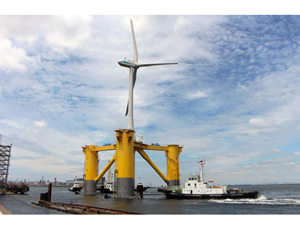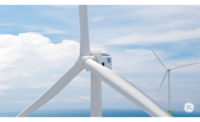
Weeks before Japan restarted the first nuclear reactor of the 48 that were shut down following the 2011 Fukushima disaster, a Marubeni Corp.-led consortium installed what it touts as, to date, the world’s largest offshore wind turbine. The 7-MW component is for a 14-MW wind farm under construction in the Onahama Port test area of Fukushima.
The turbine stands 105 meters from sea level to the rotor center and 188.5 m to the highest point on the turbine, according to a July 30 consortium news release in Japanese.
The project's second phase was delayed by four consecutive typhoons. Crews on June 7 completed installation of the 7-MW hydraulic-drive wind turbine on a three-column, semi-submergible floating platform in water 120 m deep, said a Fukushima Offshore Wind Consortium spokesman via email. Mooring work, using eight 41-ton anchors, is now underway. Once that task is complete, crews will connect the 7-MW turbine to the 66-kW floating substation, built in phase one. Last year, Marubeni installed a turbine riser cable that extends about 2 kilometers to the substation.
The completed wind farm will include the 7-MW turbine, installed in June; a 2-MW turbine, installed during phase one; and one 5-MW turbine, which has yet to be installed, the spokesman said. Fabrication of the 5-MW downwind turbine will take place at Hitachi Zosen Corp.’s Sakai Works, Osaka, with plans for installation in 2016, the spokesman said.
The spokesman confirmed that consortium member Shimizu Corp. Chief Engineer Katsunori Shimizu said, "These turbines and anchors are designed to withstand 65-foot waves." Chains are “deliberately slackened,” as Fukushima can receive 32-ft-tall tsunami events, he said.
“If a large wave were to push the turbine up, down or to the side, the loose chains connecting the structure to the seabed would give it the freedom to move without being damaged," he said.
Funded by the Ministry of Economy Trade and Industry, the project is an effort to help with the recovery from the 2011 earthquake and tsunami that destroyed the Fukushima Nuclear Power Plant.
Electric work and commissioning is scheduled for mid-September, and the test project will begin in mid-December, according to the consortium website.
In addition to Marubeni, the consortium includes Mitsubishi Corp., Mitsubishi Heavy Industries and six other companies, as well as the University of Tokyo and the Mizuho Information & Research Institute, all based in Tokyo.
On Japan's southern island of Kyushu, Kyushu Electric Co. reactivated the No. 1 reactor at the Sendai plant in Kagoshima Prefecture. The utility wants to refire a second reactor at the same site in the fall.
The earthquake-induced March 2011 tsunami knocked the Fukushima-Daichi station off line. The subsequent meltdown prompted the country's leadership to idle all nuclear reactors throughout the nation. Japan has struggled to replace nuclear energy, which supplied 30% of its electricity. Imported coal and natural gas have sent consumers' electric bills soaring. Despite this, public opinion polls show strong opposition to refiring the idled nuclear reactors.



Post a comment to this article
Report Abusive Comment